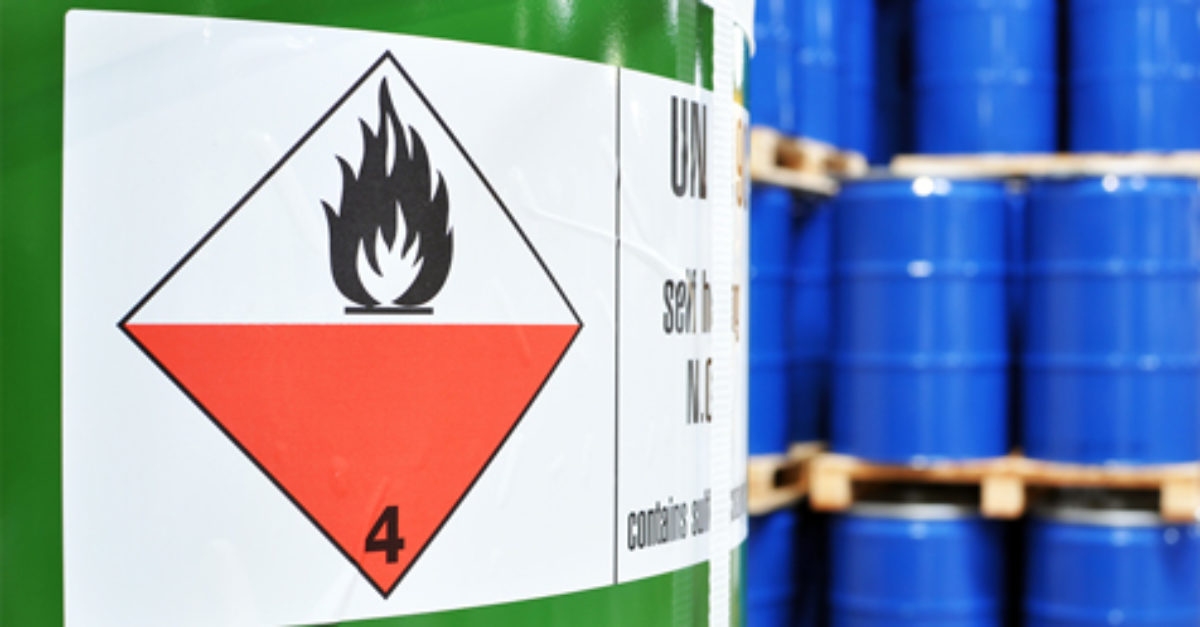Even if you manage a small facility, not a chemical warehouse, you’re most likely storing flammable liquids in your building. From aerosols to cleaning products, floor refinishing chemicals and even hand sanitizers, chances are good you have alcohol- or ammonia-based products in your custodial closet.
Although not spontaneously combustible on their own, these products can cause a fire when they encounter an ignition source. Laura Moreno, senior engineer and standards lead for the industrial and chemical group of the National Fire Protection Association (NFPA) offers five tips to help prevent fires caused by flammable liquids. Why not commemorate National Fire Prevention Week, October 4 to 10, by considering these tips to lower your facility’s risk of fires all year long.
1. Keep chemicals contained
It’s best to keep cleaning chemicals and other flammable products in their original containers or those specified by the NFPA 30, Flammable and Combustible Liquids Code. Appropriate containers include those made of metal, durable plastic, and glass. “An over-the-counter plastic container isn’t a safe option,” Moreno said. “It could decompose when it comes in contact with corrosive cleaning materials and could melt quickly in a fire involving alcohol-based fluids.”
Facilities that store large amounts of hazardous materials, such as warehouses, often store flammable chemicals in industrial drums or portable tanks. Facilities that need a smaller quantity of product—only enough to fit in custodian’s closet—should stick to the original packaging or a NFPA 30-approved container.
2. Avoid excessive heat
Most ambient temperatures are safe for storing flammable liquids, Moreno said, adding a facility would need to reach about 300 to 500 degrees Fahrenheit before most flammable liquids could spontaneously burst into flames. Check the product’s safety data sheet (SDS) to determine the maximum temperature that is safe for storing that particular liquid.
Earlier this year, a social media post showing pictures of a burned car due to hand sanitizer left inside the automobile on a hot day garnered a lot of attention. However, the claim that the hand sanitizer spontaneously combusted was later refuted. The NFPA affirmed that it would be highly unlikely for hand sanitizer to burst into flames without coming in contact with an ignition source, even in a hot environment.
3. Watch your threshold
Each facility, depending on its size, has a different threshold for the amount of flammable chemicals it can safely store. Facility mangers in a smaller building with limited storage in a custodian closet will obviously have a lower threshold than a large facility with a warehouse. In addition to size, each facility’s chemical storage threshold is also based on various factors such as the thickness or fire rating of its walls, its building code, and its sprinkler system, Moreno explained.
Facility chemical storage thresholds are not static, they can change due to restructuring or remodeling. For instance, if shelving units that hold flammable chemicals are rearranged, the facility manager will need to determine if the sprinkler system installed over the shelving is still effective.
“We call that management of change,” Moreno said. “Facility managers must make sure to evaluate any consequences of these changes.”
Thresholds can also be breached when facility managers looking to protect building residents order larger than normal supplies of cleaning and hygiene products.
“During the pandemic, the NFPA has received calls from building managers who wanted to stock up on hand sanitizer and ordered several gallons,” Moreno said. “When it arrived, they realized their facility wasn’t built to hold such a large quantity of chemicals and they needed advice on how to divvy it up so one area of their building isn’t overloaded with flammable liquid.”
4. Keep away from flames
In addition to adequate storage space, facilities need a safe storage space far from any ignition sources. Obvious locations to avoid storing chemicals include areas where people smoke or vape and places where hot work is performed such as welding and soldering, Moreno said. Less obvious areas are those where sparks can be spread through the building’s HVAC system.
“It’s rare, but we’ve seen a couple of instances where hot work was being done in one area and the building’s HVAC system spread sparks from that work to chemical storage areas,” Moreno said. “Make sure the HVAC system is monitored and shut down as needed so it can’t bring sparks to unintended places.”
5. Inform the fire department
If your facility is conscientious in following safe chemical storage protocols, you will substantially lower your risk of a fire. However, it is always best to be prepared for the worst possibility. Moreno advises facility managers to give their local fire department a list of flammable materials kept on site. “This is a good idea even for a small facility or for a school,” she said. “That way firefighters can have a plan in place before a fire so they’re not running into a building not knowing what materials are there.”




